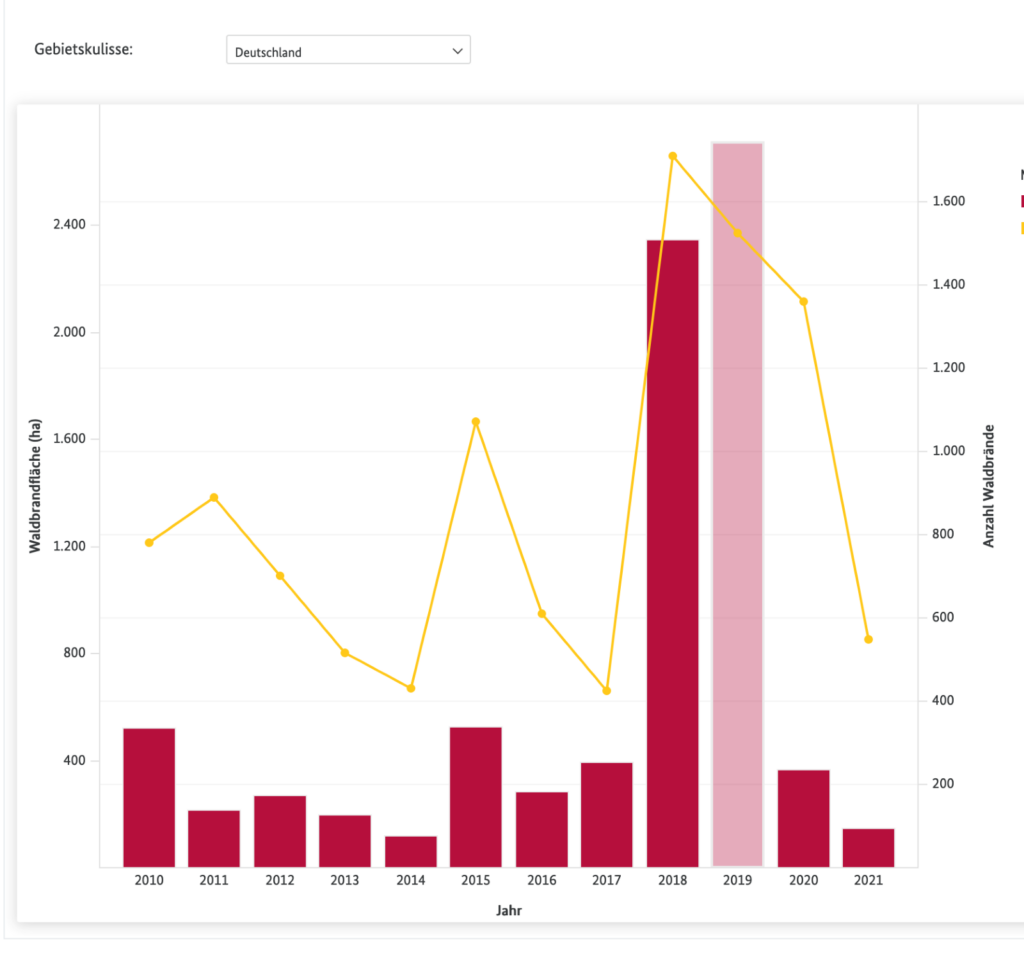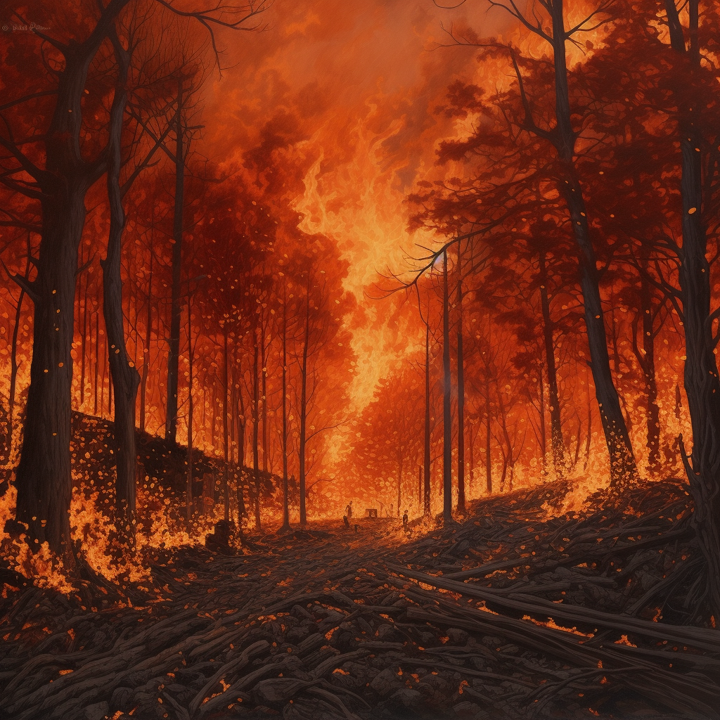Alle Jahre wieder, man kann fast die Uhr danach stellen, folgen die gleichen Meldungen in den Medien. Eine davon betrifft Waldbrände. Wenn es lange Zeit nicht geregnet hat, dann begünstigt diese Tatsache Waldbrände. Die Temperatur ist dabei fast nicht entscheidend. Waldbrände gibt es auch im Frühjahr, es muss nur lange genug nicht regnen. Es kann sie sogar im Winter geben. Die Monate mit den meisten Bränden in Deutschland sind der April und der Juni.
So ist es auch dieses Jahr ein wiederkehrendes Ritual. Der Wald um das brandenburgischen Jüterbog brennt. Reflexartig wird der Klimawandel aus der Kiste geholt. Das ist aber allenfalls nur bedingt richtig. Waldbrände entstehen fast immer durch Menschen, entweder absichtlich oder fahrlässig. Das Problem bei Jüterbog (und auch anderen Waldflächen) ist die Tatsache, dass sie jahrzehntelang militärische Übungsplätze waren. Der Boden ist verseucht mit Munition, Löscharbeiten sind lebensgefährlich. In Jüterbog kann die Feuerwehr nur aus geräumten Gassen heraus das Feuer bekämpfen, was aber nicht erfolgreich sein kann. Man lässt das Feuer dort walten, solange keine Menschen gefährdet sind. Erschwerend kommt dazu, dass in Brandenburg sehr viele Nadelbäume die Wälder prägen. Ihre Nadeln brennen bei Feuer besonders gut und tragen es weiter.
Die Chance, dass auch um Jüterbog Menschen den Wald angezündet haben, ist groß, ganz gleich ob aus krimineller Energie oder aus Blödheit. Dennoch werden wir in den Medien nur vom Klimawandel lesen, aber nichts, von fehlender Adaption. In andere Teilen Brandenburg ist es ebenfalls trocken, aber dort können Feuer gelöscht werden, weil wir Menschen uns darauf eingestellt haben und Feuerwehren löschen können. Es ist zudem auch einfacher mit Achselzucken auf das Klima zu verweisen, statt die Räumung der Munition zu veranlassen. Das ist teuer und offenbar nicht gewollt. Die Tagesschau dazu:
“Die Feuerwehr stellt sich darauf ein, dass der Einsatz gegen den Waldbrand auf einem ehemaligen Truppenübungsplatz bei Jüterbog (Teltow-Fläming) noch Tage dauern wird. Die Feuerwehrleute kommen nicht nah genug an die Brandherde heran, weil das Gebiet mit alter Munition stark belastet ist. Es sei nur möglich, sich wegen der Explosionsgefahr auf geräumten Wegen rund um das Gebiet zu bewegen. Die Feuerwehr kontrolliere den Brandschutzstreifen und halte ihn nass, um zu verhindern, dass das Feuer auf weitere Areale übergreift. „Es ist frustrierend für den Feuerwehrmann, der hier steht und nichts machen kann“, sagte Feuerwehr-Einsatzleiter Rico Walentin. Insgesamt betrachtet dehne sich der Brand weiter aus und die Rauchentwicklung nehme wieder und ziehe in Richtung Treuenbrietzen, warnt die Feuerwehr.”
Das Landwirtschaftsministerium hat interessante Daten und Fakten zu dem Thema Waldbrand. Leider fehlen noch die 2022er Daten. Sie erscheinen erfahrungsgemäß im Sommer. Bis 2021 sah der Trend jedenfalls so aus wie auf dem Chart. Das passt nur schwer zur Gleichung, es wird immer schlimmer.

(Abbildung: Screenshot BMEL)
Wir hatten bereits im Jahr 2019, das ist das Jahr mit einem extremen Peak über das Thema geschrieben und auch über die Reflexe der bekannten Protagonisten. Es hat sich nicht viel daran geändert.
+++
Ladestrom als Luxusprodukt. Preise bis zu 1 Euro pro kWh werden laut Edison Media aufgerufen.
“Es gibt weiterhin Standorte, an denen Besitzer von Elektroautos den Ladestrom noch für 41 Cent pro Kilowattstunde (kWh) beziehen können. Doch wer nicht aufpasst, kann auch schon einmal 1,01 Euro zahlen. Das zeigt die Auswertung von rund 2,5 Millionen Ladevorgängen im öffentlichen Raum durch die Experten von Cirrantic und TheonData.
Nach der Analyse sind die Ladestrom-Preise seit dem Jahreswechsel deutlich gestiegen und lagen Ende April im Schnitt schon bei 65 Cent/kWh. Die jüngsten Preiserhöhungen beim VW-Ladedienstleister Elli und beim Skoda Powerpass sind dabei noch nicht berücksichtigt. Elli hat mit Wirkung zum 1. Juni sein Tarifsystem angepasst und dabei zwar die Mindest-Vertragslaufzeiten verkürzt, aber die Strompreise um acht bis 15 Cent pro Kilowattstunde angehoben.”
+++
Leserpost von Marco Schmautz:
Betreff: Sea ice may soon disapear from the Artic
Al Gore hatte schon anlässlich seiner Nobelpreisverleihung behauptet, dass Wissenschaftler Erkenntnisse hätten, wonach das Sommerseeeis der Artik schon im Jahre 2013 verschwunden sein wird. Dem ist eigentlich nichts mehr hinzuzufügen.
+++
Finnland baut das erste Tiefenlager für radioaktive Abfälle der Welt. Alex Reichmuth hatte die Gelegenheit, das imposante Bauwerk zu besichtigen und auf über 450 Meter Tiefe hinabzusteigen. Er hat für den Nebelspalter eine Reportage und einen Kommentar geschrieben.
In der Unterwelt von Olkiluoto
Es geht hinunter und immer weiter hinunter. Scheinbar endlos ziehen sich die Tunnels hin, denen wir mit einem Auto folgen. Ab und zu passieren wir ein Tor oder eine Schleuse. Und immer folgt dahinter ein neuer Schacht.
Insgesamt fünf Kilometer lang ist die Reise in die Unterwelt der finnischen Insel Olkiluoto. Am Ende befinden wir uns über 450 Meter unter dem Boden, ausgerüstet mit Gummistiefeln, Helmen, Handschuhen und Warnwesten. Willkommen in Onkalo, dem weltweit ersten Tiefenlager für hochradioaktive Abfälle.
Der Aufwand ist kaum zu rechtfertigen
In Onkalo in Finnland kann einem schwindlig werden. Nicht nur wegen dem Gewirr an unterirdischen Gängen im weltweit ersten Tiefenlager für radioaktive Abfälle. Sondern auch wegen des Aufwands, der hier getrieben wird.
Jahrzehntelange Aushubarbeiten. Dutzende von Kilometern an Tunnels. 3,5 Milliarden Franken.
Weiterlesen im Nebelspalter: hier und hier.
+++
Study reveals presence of Hunga Tonga eruption aerosols in Northern Hemisphere stratospheric westerlies
An international team led by researchers from the Institute of Atmospheric Physics (IAP) of the Chinese Academy of Sciences has detected aerosols from the Hunga Tonga eruption in the Northern Hemisphere stratospheric westerlies for the first time.
This discovery, published in Science Bulletin, will aid in simulating the physical and chemical processes in volcanic plumes.
The Hunga Tonga-Hunga Ha’apai volcano, located in the South Pacific Ocean, erupted in January 2022, spewing ash and gas into the atmosphere. The eruption was one of the largest in recent years and was closely monitored by scientists worldwide.
The purpose of the Sounding Water vapor, Ozone, and Particle (SWOP) campaign is to better understand the temporal and spatial distribution characteristics of atmospheric compositions over the Tibetan Plateau. Capturing the volcanic aerosols from the Hunga Tonga eruption was unexpected, according to Prof. Bian Jianchun, an IAP scientist and a team leader of the SWOP campaign.
„We happen to have captured the volcanic aerosols from the Hunga Tonga eruption 12 weeks after it erupted. To my knowledge, this is the first time that it’s been detected at the stratospheric westerlies in the Northern Hemisphere,“ said Prof. Bian.
Large uncertainties still remain in understanding physical properties and evolutionary process of volcanic aerosols in the stratosphere, particularly SO2 oxidation in volcanic plumes and clouds and the interaction between ash and sulfate aerosols after volcanic eruptions. In-situ measurements obtained in volcanic plumes, especially measurements of the microphysical parameters of volcanic aerosols, provide compelling evidence that reduces these uncertainties. However, it is difficult to obtain these parameters, especially during the occurrence of volcanic eruptions.
During the SWOP campaign carried out over the Tibetan Plateau, a balloon-borne payload consisting of the Compact Optical Backscatter Aerosol Detector (COBALD) and the Portable Optical Particle Spectrometer (POPS) was released in Lijiang, Yunan province on April 9, 2022. Unexpectedly, the balloon captured the size spectrum of volcanic aerosols at 24–25 km.
The Hunga Tonga volcanic aerosol was identified by the size distribution of the aerosol diameter, which was centered at approximately 0.42–1.27 μm, larger than the background mode (0.22–0.42 μm) of stratospheric aerosols, and particle number densities of approximately 1 cm-3. The backscatter ratios derived from the COBALD measurements at 455 nm and 940 nm both showed enhanced aerosol signals between 24 and 25 km. Additionally, measurements showed that the aerosol and water vapor layers were separated in the Hunga Tonga plume.
These findings suggest that volcanic eruptions have potential impact on regional and global atmospheric circulation and climate, even thousands of kilometers away from the source. The possible mechanisms that led to the separation of aerosol and water vapor layers in the Hunga Tonga plume will be examined in future study.
Paper: Jianchun Bian et al, First detection of aerosols of the Hunga Tonga eruption in the Northern Hemisphere stratospheric westerlies, Science Bulletin (2023). DOI: 10.1016/j.scib.2023.03.002
+++
Morgan Rehnberg in Eos:
Dust lifted into the air by cyclones provides anchor points for cloud-forming ice
Cirrus clouds are high-altitude (8–17 kilometers) clouds composed of pure ice particles. These clouds have a significant impact on the planet’s climate by scattering incoming sunlight and absorbing Earth’s emitted infrared radiation. In a new study, Zeng et al. discovered new details about how these wispy, hair-like clouds form in large storm systems.
Ice forms cirrus clouds in two ways. In homogeneous nucleation, drops of liquid water spontaneously freeze when they encounter the appropriate conditions. In heterogeneous nucleation, a secondary particle, such as a mote of dust, provides a site around which the ice crystal forms. The heterogeneous pathway operates in a wider range of conditions, but it requires the presence of adequate debris.
In the past, researchers thought that ice crystals in cirrus clouds formed mostly through homogeneous nucleation because of low temperatures and the lack of ice-nucleating particles at high altitudes. In the new study, the scientists suggest that under the right conditions, heterogeneous nucleation may play a larger role than previously appreciated.
The researchers tested the role that strong storms called dust-infused barocline storm systems (DIBS) play in cirrus cloud formation. These storms lift dust particles from Earth’s surface into the atmosphere through warm conveyor belts. Prior research using satellite data revealed that cloud tops of DIBS have unusual, cirrus-like properties. In the new study, the scientists used satellite data and modeling to show that extremely high ice crystal concentrations in DIBS cirrus are formed through heterogeneous freezing.
The study drew on data from a May 2017 DIBS event in East Asia recorded by four separate weather satellites. The imaging, spectroscopic, radar, and lidar data indicated that the 2017 storm produced extremely high ice particle concentrations of 1 to 10 particles per cubic centimeter, with particle sizes in the range of 10 to 30 micrometers.
These data were used in a weather forecasting model (WRF-Chem). The authors ran the model in two configurations: one simple model that depended only on temperature and a second, more complex model that included additional factors like the surface area of nucleating particles.
The authors found that the more sophisticated parameterization matched cloud observations more closely than the simple model: The new, more complex model yielded ice particle concentrations that were 10 to 100 times higher and particle sizes that were 2 to 3 times smaller. These findings, the authors say, indicate that ice crystals in DIBS are formed through heterogeneous nucleation of dust particles.
The findings provide a mechanism of cirrus cloud formation in DIBS that the authors say should be incorporated into future climate models.
The study is published in the Journal of Geophysical Research: Atmospheres.
Paper: Yi Zeng et al, Extremely High Concentrations of Ice Particles in East Asian Dust‐Infused Baroclinic Storm (DIBS) Cirrus Shield: Dominant Role of Dust Ice Nucleation Effect, Journal of Geophysical Research: Atmospheres (2023). DOI: 10.1029/2022JD038034
